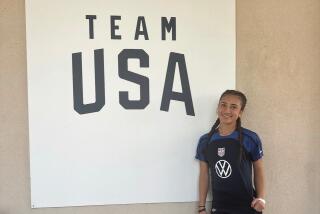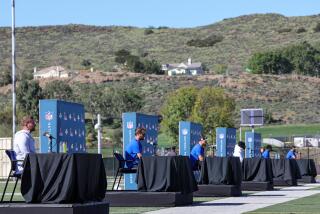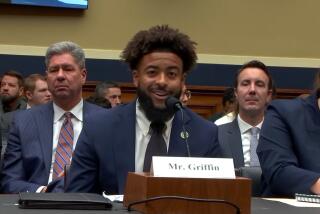A Cure for Growing Pains : CSUNâs Talented Trainers Are Moving to Bigger Facility
NORTHRIDGE â Alice McLaine once treated a gymnast who went into shock after dislocating both elbows during a practice routine.
Itâs the worst injury McLaine saw in her 15-year career as an athletic trainer.
âTo think when I got into this field my relatives thought I just taped ankles and gave rubdowns,â said McLaine, director of the athletic training education program at Cal State Northridge.
Rhonda Lowry, the Matadorsâ head athletic trainer, recalls two bad injuries during her 12 years in the field. The first was during football practice as a student trainer at Nevada Las Vegas.
She witnessed a collision between two players, the powerful blow causing severe spinal injury to one.
âHe dropped like a dead weight,â Lowry said. âIt was very scary. Later on he was able to walk, but he can only do it with crutches.â
The other incident involved a Santa Clara football player who suffered a concussion in a 1986 game at North Campus Stadium.
He died the next day.
âThatâs the worst injury weâve had here at CSUN,â Lowry said.
Athletic trainers stay behind the scenes waiting for something to happen and hoping that nothing does. They want the experience of treating a major injury, but prefer not to see one.
McLaine, who spent most of her career as a trainer at Iowa State, now spends most of her time in a classroom teaching students. The transition wasnât easy.
âI miss the relationship with the athletes,â said McLaine, who came to Northridge in 1991. âBut I donât miss the schedule.â
As the mother of two small children, McLaine is glad to be home on weekends and most evenings instead of nursing athletes during games.
Lowry has been the Matadorsâ head trainer since 1984. She treats athletes, sits through most of the schoolâs home athletic events and supervises student trainers.
If a major injury occurs, Lowry usually takes care of it. Otherwise, she scrutinizes how student trainers handle various situations.
At times that may include a difference of opinion between an ambitious coach who wants an athlete in a game and a trainer who tends to be conservative in clearing an injury.
âCoaches and trainers often clash,â Lowry said. âBut trainers overrule the coach.â
John Price doesnât recall disagreeing with a trainer in 11 seasons as Northridge menâs volleyball coach.
âThey do a great job,â Price said. âIâm also a low-maintenance coach. They constantly give me more information than I want to know. I just want to know if the athlete can play.â
Every Matador team has a student trainer who attends each practice and game, even on the road.
Northridge has one of only five athletic training programs in the state accredited by the National Athletic Trainersâ Assn. The others are at Fresno State, Long Beach State, Cal State Sacramento and San Jose State.
There are 91 NATA certified programs in the nation and for years Northridge has been among the most highly regarded.
However, the same could not be said of the schoolâs athletic training facility. It was built in the 1960s and is primitive compared to those at most Division I colleges.
That will change sometime in mid-June when the department moves to a new, state-of-the-art facility across the courtyard from the old one.
An 86,000-square-foot kinesiology building will feature instruction labs, a gym and a dance studio.
The area where athletes will be taped and treated for injuries is about three times as large as the one in the old building.
âWeâll have more equipment and up-to-date computerized machines,â Lowry said. âWeâre excited.â
Student trainers are equally thrilled, as are coaches and athletes.
âThe facility theyâre in now is horrible,â Price said. âItâs kind of embarrassing compared to other schools we go to.â
The Northridge athletic training program has 30 students who are required to work 1,200 hours in direct contact with a certified trainer before graduating.
Last year, 90% of the graduates found jobs in the field, McLaine said, after passing their certification examination.
Carolyn Jones, who worked with the womenâs basketball team this past season, will take the test in August. She plans to work at Newbury Park High as a teacher and athletic trainer next year.
âI became interested in this as a student at Chatsworth High,â Jones said. âI saw a football player break his neck in a game and it just struck my interest.â
Fortunately, nothing like that has happened to Northridge athletes.
Said Lowry: âWeâve been lucky.â
More to Read
Get our high school sports newsletter
Prep Rally is devoted to the SoCal high school sports experience, bringing you scores, stories and a behind-the-scenes look at what makes prep sports so popular.
You may occasionally receive promotional content from the Los Angeles Times.






